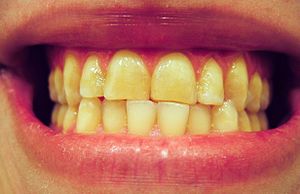Bruxism
| Bruxism | |
|---|---|
 |
|
| Attrition (tooth wear caused by tooth-to-tooth contact) can be a manifestation of bruxism. | |
| Classification and external resources | |
| Specialty | Dentistry |
| ICD-10 | F45.8 ("tooth grinding") |
| ICD-9-CM | 306.8 |
| DiseasesDB | 29661 |
| MedlinePlus | 001413 |
| MeSH | D002012 |
Bruxism is excessive teeth grinding or jaw clenching. It is an oral parafunctional activity; i.e., it is unrelated to normal function such as eating or talking. Bruxism is a common problem; reports of prevalence range from 8–31% in the general population. Several symptoms are commonly associated with bruxism, including hypersensitive teeth, aching jaw muscles, headaches, tooth wear, damage to dental restorations (e.g. crowns and fillings) and damage to teeth. However it may cause minimal symptoms, and therefore people may not be aware of the condition.
There are two main types of bruxism: that which occurs during sleep (sleep bruxism) and that which occurs during wakefulness (awake bruxism). Dental damage may be similar in both types, but the symptoms of sleep bruxism tend to be worse on waking and improve during the course of the day, and the symptoms of awake bruxism may not be present at all on waking, and then worsen over the day. The causes of bruxism are not completely understood, but probably involve multiple factors. Awake bruxism is thought to have different causes from sleep bruxism, and is more common in females, whereas males and females are affected in equal proportions by sleep bruxism. Several treatments are in use, although there is little evidence of robust efficacy for any particular treatment.
Most people who brux are unaware of the problem, either because there are no symptoms, or because the symptoms are not understood to be associated with a clenching and grinding problem. The symptoms of sleep bruxism are usually most intense immediately after waking, and then slowly get better, and the symptoms of a grinding habit which occurs mainly while awake tend to slowly get worse throughout the day, and may not be present upon waking. Bruxism may cause a variety of signs and symptoms, including:
Bruxism is usually detected because of the effects of the process (most commonly tooth wear and pain), rather than the process itself. The large forces that can be generated during bruxism can have detrimental effects on the components of masticatory system, namely the teeth, the periodontium and the articulation of the mandible with the skull (the temporomandibular joints). The muscles of mastication that act to move the jaw can also be affected since they are being utilized over and above of normal function.
Many publications list tooth wear as a consequence of bruxism, but some report a lack of a positive relationship between tooth wear and bruxism. Tooth wear caused by tooth-to-tooth contact is termed attrition. This is the most usual type of tooth wear that occurs in bruxism, and affects the occlusal surface (the biting surface) of the teeth. The exact location and pattern of attrition depends on how the bruxism occurs, e.g., when the canines and incisors of the opposing arches are moved against each other laterally, by the action of the medial pterygoid muscles, this can lead to the wearing down of the incisal edges of the teeth. To grind the front teeth, most people need to posture their mandible forwards, unless there is an existing edge to edge, class III incisal relationship. People with bruxism may also grind their posterior teeth (back teeth), which wears down the cusps of the occlusal surface. Once tooth wear progresses through the enamel layer, the exposed dentin layer is softer and more vulnerable to wear and tooth decay. If enough of the tooth is worn away or decayed, the tooth will effectively be weakened, and may fracture under the increased forces that occur in bruxism.
...
Wikipedia
